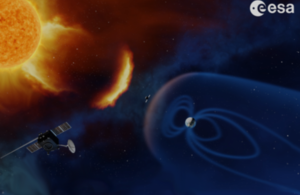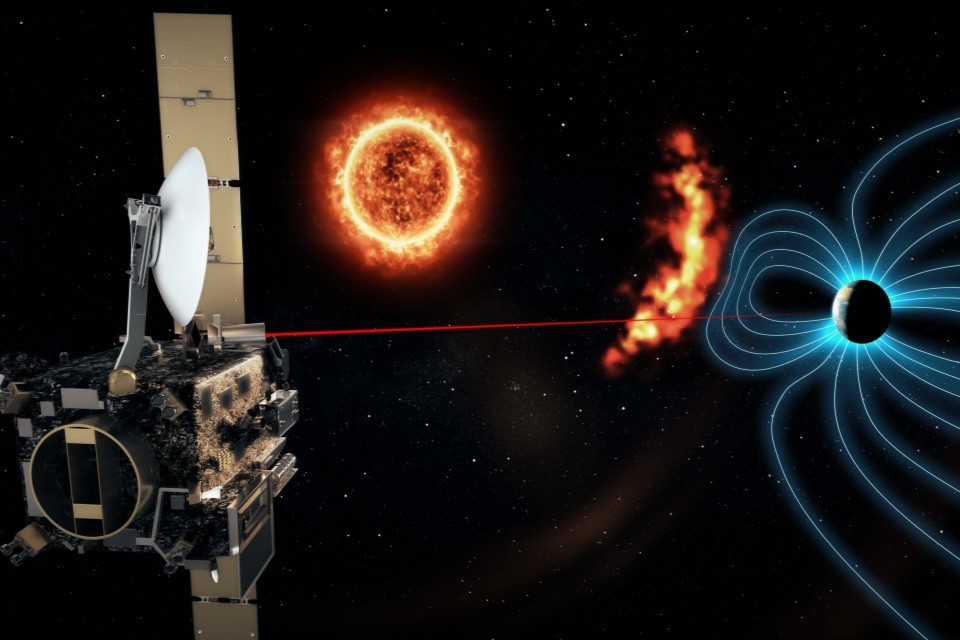UK teams complete space weather mission study ahead of selection decision in November
The first phase of design work for the European Space Agency’s Lagrange spacecraft has been completed, with three out of the four multinational teams led by the UK.

space weather [Credit: ESA]
This ESA mission, together with a complementary US mission, will form the major elements of an early warning system for severe space weather, which can be hazardous to critical infrastructure on Earth and human life in space.
Three out of four teams developing the platforms and instruments to support the ESA mission are led by UK organisations, with a fourth from Germany. This has allowed the UK and Germany to develop a mission focused on the needs of operational 24/7 forecasting.
This will be the first deep space mission where the priority is to deliver critical services, with excellent science as a by-product.
The proposed mission will be put to ESA member states in November at the Council of Ministers meeting, Space19+, and is targeted for launch in 2025.
This comes as the European Space Science Committee (ESSC), an Expert Board on Space Sciences hosted by the European Science Foundation (ESF), today presented its recommendations on how ESA, the European Union (EU) and their respective member states can face space weather risks.
The ESSC report identifies six activities which it says need urgent coordination. They include supporting the next generation of space missions and the maintenance and augmentation of ground-based infrastructure and assessment of risks at national, regional and European levels.
How would the ESA and US missions work together?
The US mission will travel to a location known as Lagrange point L1 where it can monitor the Sun and solar wind in a direct line between sun and Earth. The ESA mission will go to a different location, known as Lagrange Point L5, where it can observe the Sun and the space in between the Sun and earth (the inner heliosphere), from a fixed viewpoint away from the sun-Earth line. This unique vantage point will also allow it to detect events developing on the Sun before they become visible from the orbit of the Earth.
When taken together, the L1 and L5 missions will provide a 3D view that will greatly increase the accuracy of space weather forecasts.

ISRR artist impression [Credit: Airbus/ESA]
In the UK, Airbus Defence and Space Ltd lead on developing the overall mission concept for the L5 mission, STFC RAL Space on optical instruments to observe the sun and inner heliosphere and UCL’s Mullard Space Science Laboratory on instruments to measure the solar wind.
Space weather appears on the National Risk Register due to the damage that extreme events may cause to satellites, power distribution networks, air transportation, satellite navigation, telecommunications links and mobile phone networks. The worst impacts can be avoided with sufficient warning, which the Lagrange mission will enable. Last month the UK government awarded £20 million funding into research to improve forecasts, identify vulnerabilities and better prepare our infrastructure to cope with extreme space weather.
Commenting on this announcement, Prime Minister Boris Johnson said:
From solar flares to magnetic storms, space weather can have a massive impact on mobile phones, transport, GPS signals and the electricity networks we rely on every day at home.
The funding… will help turn Britain’s pioneering research into practical solutions that will protect against any adverse disruption caused by cosmic chaos.
The UK’s leading role in ESA helps to develop national space capabilities and foster international collaboration, inspiring the next generation of scientists and engineers and creating jobs and economic growth. The commitments the UK will make in November are a part of the Government’s ambition to increase research and development spending to 2.4% of UK GDP by 2027, and our efforts to play a leading role in the new space age.
Professor Andrew Fazakerley, Director of the UCL Mullard Space Science Laboratory, said:
UCL has many years of research experience in the science of space weather and in building instruments with which to study it, including providing both solar and space plasma instruments for ESA’s upcoming Solar Orbiter mission due to launch in 2020.
We are fortunate to be leading a very talented team of European institutes in developing one of two suites of instruments to support the ESA Lagrange mission, which, when placed in deep space, will give early warning of imminent, damaging space weather. This will allow us to better protect astronauts, satellites and ground infrastructure from disruptive space weather - something we’ve never been able to achieve before.